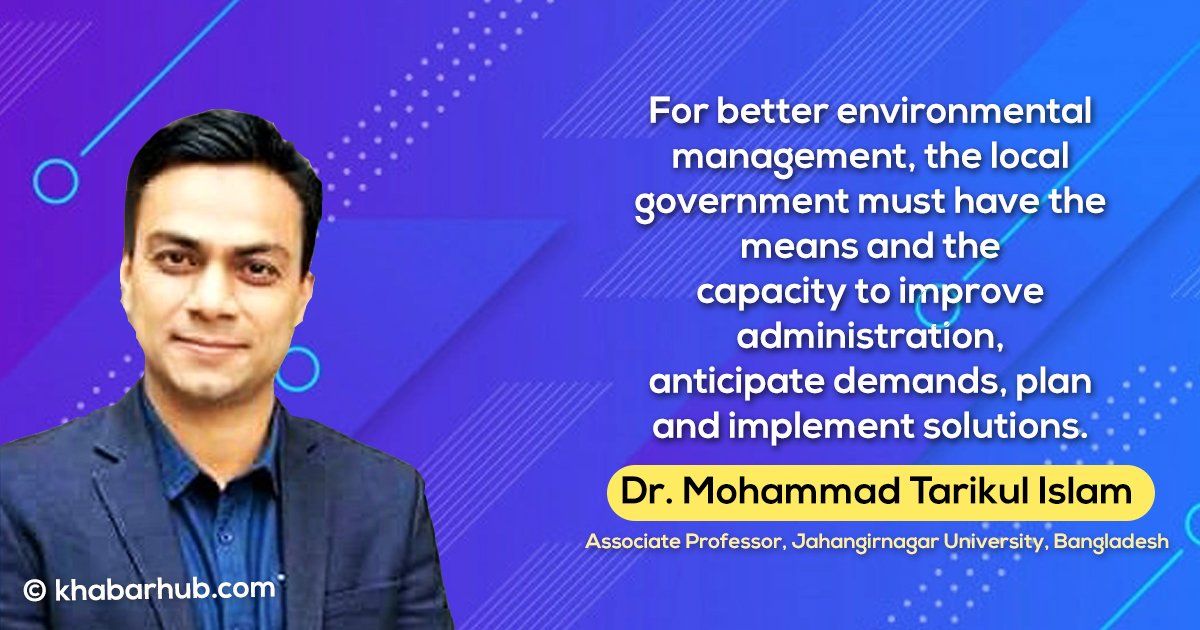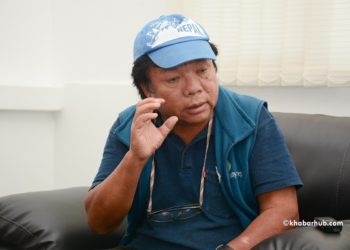Bangladesh is recognized to be one of the most susceptible countries in the world, highly vulnerable to climatic manifestations as a result of its unique geographic location, hydro-geological characters like the dominance of floodplains, low elevation from the sea and lastly the socio-economical characters like high population density, high levels of poverty, and overwhelming dependence on nature.
The physical environment of Bangladesh is diverse, and there is a mix of both traditional and modern methods of land use, all very closely adapted to the heterogeneous conditions.
The existence of the planet Earth is threatened due to climate change and environmental degradation which is again induced by the rapid growth of economy, urbanization and population.
Bangladesh is also facing various environmental crises like climate change, water pollution, air pollution, noise pollution and hazardous waste.
Apparently, clear leadership and a common vision of environmental governance as developmental and distinct from environmental management have the essence to put governance into the domain of development.
Environmental governance is perceived as everyone’s business and all stakeholders both state and non-state must adopt governance into their respective development plans to mainstream for reducing disaster risk and enabling vulnerable people to manage live and livelihood with security and less risk.
This complexity of environment and utilization patterns has important implications for the vulnerability and depletion of the natural resource base.
Bangladesh Climate Change Strategy and Action Plan, 2009 (BCCSAP 2009) is being implemented to address the impact of climate change where both adaptation and mitigation activities have been considered.
Environmental governance examines threats posed by environmental events and trends to individuals, communities, or nations. Environmental governance is environmental viability for life support, with three sub-elements:
a. Preventing or responding to environmentally caused conflicts, and
b. Protecting the environment due to its inherent moral value,
c. Preventing or repairing military damage to the environment.
The existing natural forests in Bangladesh are decreasing at a rate varying from 2.1 percent/year to 3.3 percent/year.
This is due to the exploitation of forest resources for commercial logging, fuelwood collection as well as agricultural land expansion.
Commercial logging provides a viable income for the poor as the timber logs could be sold for cash. This monetary benefit could encourage more trees to be felled resulting in deforestation.
Ensuring access to clean water and sanitation is usually a responsibility of local governments, and relies on effective local governance, natural resource management, and urban planning.
Local governments have a role to play in improving water quality through environmental protection measures and sustainable solid waste management.
The rural poor have been more marginalized than the urban poor in getting access to health facilities. The impact of health security on human capital and socio-economic development is widely acknowledged.
Good health reduces the loss of working time work and increases school attendance for children. Health constitutes an important element in both the Human Development Index (HDI) and the Human Poverty Index (HPI).
Being healthy is a valuable achievement in itself, and can be of direct importance to a person’s effective freedom.
Local and regional governments, especially in cities, are often on the frontline of dealing with the effects of climate change.
Our capacities to deal with climate-related hazards and natural disasters must be strengthened so that we can protect our communities, particularly the most vulnerable.
Local leaders have a history of leading from the bottom up in combatting climate change and raising awareness at the local level.
While formulating environmental policy, different actors and factors played some direct and indirect roles. All the actors, whether external or internal, played pertinent roles in the formulation of the environmental policy.
The Government of Bangladesh has taken several significant steps during the last decades for building up institutional arrangements from national to the union levels for effective and systematic disaster management.
In line with the Stockholm mandate 1972, the government of Bangladesh actively participated in the generic process of protecting the global environment.
In order to put the Stockholm mandate into effect, the Bangladesh government had promulgated the first Water Pollution Control Ordinance in 1973 as well as the Environment Pollution Control Ordinance in 1977.
To carry out the environmental program on the ground, in 1985 Department of Pollution Control Ordinance was established and it has been renamed and structured as the Department of Environment (DOE) afterward.
The idea of environmental protection through national efforts was first recognized and declared with the adoption of the Environmental Policy 1992.
While formulating environmental policy, different actors and factors played some direct and indirect roles. All the actors, whether external or internal, played pertinent roles in the formulation of the environmental policy.
In the context of the environment, the Government of Bangladesh formulated an Environment Policy in 1992. Key elements of the environment policy are maintenance of the ecological balance and overall progress and development of the country through protection and improvement of the environment; protection of the country against natural disasters; identification and regulation of all types of activities which pollute and degrade the environment.
The Government of Bangladesh has recognized climate change as an important issue and attempts are being made to incorporate potential response measures for reducing the impacts of climate change into the overall development planning process.
It is being increasingly recognized that the adverse impacts of climate change in an already vulnerable country such as Bangladesh will put additional stress on the overall development of the country.
The National Adaptation Programs of Action (NAPA) is prepared by the Ministry of Environment and Forest (MOEF), Government of the People’s Republic of Bangladesh in 2005 as a response to the decision of the Seventh Session of the Conference of the Parties (COP7) of the United Nations Framework Convention on Climate Change (UNFCCC).
The basic approach to NAPA preparation was along with the sustainable development goals and objectives of the country where it has recognized the necessity of addressing the environmental issue and natural resource management with the participation of stakeholders in bargaining over resource use, allocation and distribution.
Protection of the environment is a crucial challenge for the bio-diversity rich developing countries like Bangladesh.
As the economic growth and development of the country largely depend on natural resources, it is important to ensure sustainable environmental development.
According to ‘Vision 2021’, the Government of Bangladesh has been implementing various programs incorporating the measures of environmental pollution control and the impact of global warming.
Meanwhile, Bangladesh has achieved the target of ensuring safe drinking water and sanitation for all people as envisaged in the Millennium Development Goal (MDG) set by the United Nations.
In a developing country like Bangladesh where’s above 70% of people live in the rural area are confronted with various environmental threats that endanger the human governance of them.
The Government also integrated the Sustainable Development Goals (SDGs) in the Seventh Five Year Plan (2016-2020) and has set 11 targets in it. Bangladesh has introduced the mapping of ministries, data analysis and national monitoring and evaluation framework for SDGs implementation.
Bangladesh Climate Change Strategy and Action Plan, 2009 (BCCSAP 2009) is being implemented to address the impact of climate change where both adaptation and mitigation activities have been considered.
Bangladesh Climate Change Trust Fund (BCCTF) has been formed from internal resources in implementing BCCSAP 2009 and allocated a total amount of Tk.3,100 core from the FY2009-10 to FY2016-17.
Moreover, the Government has enacted the Climate Change Trust Fund Act 2010 and formulated a Climate Change Trust Fund Policy for better management of BCCTF.
In addition to that Bangladesh Climate Change Resilience Fund (BCCRF) has also been formed with the assistance of development partners in implementing BCCSAP 2009.
Finance Division has undertaken a Technical Assistance Project titled Inclusive Budgeting and Financing for Climate Resilience (IBFCR) funded by UNDP at an estimated cost of Tk.185.20 million.
The Ministry of Environment and Forests has also undertaken many awareness programs and reform activities for environment conservation including Ozone Layer Protection and Pollution Control. Bangladesh is rich in biodiversity which is very important to the environment and ecosystem and considering this the Government has prepared National Action Plan 2020 and many projects are being taken under this action plan.
National Bio 0safety Framework and National Biodiversity Strategy and Action Plan are being implemented and has been updated for biodiversity conservation in the country.
The Ministry of Disaster Management and Relief is also agile in implementing various programs in order to tackle eventualities emanating from natural disasters
Apart from the institution building, legislative development also facilitates mitigation to the sufferings of disaster victims in Bangladesh.
To maintain proper coordination amongst the concerned ministries, departments, line agencies, Local Government Body and community people, and also to ensure their proper functioning to diminish the sufferings of the people, the Government of Bangladesh has formulated a set of apparatuses from national down to the grass-root levels.
Environmental governance approaches in Bangladesh harmonizing systematic analysis of environmental risk reduction in Bangladesh are not well conversant in the available literature.
For these mechanisms to be the best operative, the Standing orders on Disaster (SOD) act as a guidebook. As per SOD, Disaster Management Committees are found to be in place starting from the National Disaster Management Council headed by the Honorable Prime Minister functioning to the Union Disaster Management Committee headed by the Chairman of the Union Parishad.
In a developing country like Bangladesh where’s above 70% of people live in the rural area are confronted with various environmental threats that endanger the human governance of them.
Bangladesh Government has several initiatives financed through own resource as well as an external resource to protect the environment.
Local government is the key channel of the Bangladesh government to utilize the resource for protection of the environment. Union Parishad is the only representative body of the central government that plays a vital role to ensure a safer environment in rural Bangladesh.
Any programs of union Parishad are a very significant contributor to the environmental protection of the local people living in the rural area.
Agricultural and rural development measures ensure food security for the growing population without causing environmental degradation.
Crop productivity has tremendously increased with agriculture diversification and improved technologies. To reduce reliance on irrigation and lower the risk of salinization, the storage of surface water is enhanced and rainwater harnessed.
To prevent the decline of the marine fisheries resource, fishing is regulated to avoid overexploitation. To enhance forest biodiversity, forest protected area could be extended and rural folks could be educated with knowledge on sustainable resource use.
Social security is achieved with sanitation, shelter and empowerment through education. It involves the provision of housing facilities, clean drinking water, electricity, medical services and ensuring food security for all.
No doubt, cohesively mainstreaming of environmental issues into the development planning and processes refer: to engage in a systematic, comprehensive effort to reduce the risks of prospective damages due to natural and other factors through incorporating environmental governance measures into the overall development planning process.
As a matter of fact, Bangladesh is the novice of this campaign. Only just, relevant stakeholders (the government of Bangladesh, development partners and other non-government actors) have realized that risk identification and management measures should constitute an integral part of their development planning.
Poorly planned and managed urban development, environmental degradation, poverty and inequality and weak governance mechanisms continue to drive rapidly-increasing loss and damage associated with extensive risk in Bangladesh.
Inadequate finance is the most serious problem faced by Union Parishad. The Union Parishad implements some major development projects with the annual government grants.
Environmental governance approaches in Bangladesh harmonizing systematic analysis of environmental risk reduction in Bangladesh are not well conversant in the available literature.
Moreover, the environmental governance approach in rural Bangladesh drawing examples and lessons from the international, national and community-level programs is not underlined to analyzing field experiences from academic perspectives, and to highlighting key issues and the policy relevance of environmental management.
Drawbacks in the policies as well as in the implementation of environmental governance in Bangladesh are apparent.
Lack of coordination among different stakeholders hampers quick response in times of emergency response as well as governance in environmental management.
Accountability, participation, predictability and transparency are known as the key features of a governance structure that nurtures development and complements the environmental governance efforts of the government.
Hence, Governance would be perceived as the theoretical framework of the research undertaking.
Disaster risks and environmental governance are essentially driven by a number of unsettled, underlying causes such as vulnerable rural livelihoods, poverty, poor urban governance, lack of good governance, declining ecosystem services, poor coordination, poor quality of implementation and power inequality, which eventually lead to an uneven distribution of risk both socially and spatially.
Legislative and Institutional aspects through which governance exists could mainstream disaster environment into the development of the country.
At large, government plays vital political, economic, cultural, and social roles in environmental management through resource assurance, technical support, and disaster risk management.
Three key aspects of governance relate to those roles: (a) Overall leadership: Politically, the government has a leading role for the overall rule and system design, including legislation, decision-making processes, and policy implementation mechanisms for the systematic inclusion of environmental governance under the auspicious of local government particularly at Union Parishad.
It has been understood by the academics and the policy planners that for environmental governance in a rural area there is no alternative to Union Parishad.
Union Parishad has a major responsibility to cope with local environment related contingencies like tree plantation, social awareness, arsenic mitigation, air and water pollution reduction, landslide mitigation, physical protection, natural disaster and so on by providing various aid likes installation of tube well for freshwater.
For better environmental management, the local government must have the means and the capacity to improve administration, anticipate demands, plan and implement solutions.
Likewise, it has also the responsibility for identification of arsenic affected tube well, communication with concerned authorities for proper distribution of plants, dissemination of early warning message, enforcement of government enacted rules to reduce air and water pollution, assist the concerned authority to protect embankments and help them to ensure the natural flow of water through canals and rivers, a clean movement for a healthy environment, maintenance of community shelter and coordination with different stakeholders for disaster response effectively and efficiently.
Inadequate finance is the most serious problem faced by Union Parishad. The Union Parishad implements some major development projects with the annual government grants.
The government also permits Union Parishad to levy taxes and faces on a limited number of resources. Owing to various factors, Union Parishad does not, or is unable to fully exercise its taxation powers.
On the other hand, due to the delay in the release of grant funds by the government, Union Parishad cannot play an effective role to ensure environmental governance to the rural people by initiating various programs.
Patron-client relations, undue political pressure, mismanagement, improper planning, motivation, and lack of technical knowledge also hamper the effective functioning of Union Parishad for the promotion of environmental governance in rural Bangladesh.
For better environmental management, the local government must have the means and the capacity to improve administration, anticipate demands, plan and implement solutions.
To upscale efforts, we need greater cooperation and national and international coordination mechanisms, as well as enough resources to make this happen.
We will need to ensure that citizens are involved in the decisions that affect their future. “Effective, accountable and transparent institutions” and “responsive, inclusive, participatory and representative decision-making at all levels” require a clear institutional framework, reinforced management and planning capacities, participatory mechanisms and regular financial negotiations between all levels of government and local communities to define priorities and plan of action for ensuring environmental governance.
(Dr. Mohammad Tarikul Islam is an Associate Professor of the Department of Government and Politics at Jahangirnagar University in Bangladesh. He is the Visiting Scholar of Oxford and Cambridge. Before joining the university, Dr. Islam was serving the United Nations for seven years. As a popular development columnist in South Asia, Professor Islam writes for the Daily Star, the Daily Independent, the Financial Express, The Business Time, Daily Jugantor and South Asia Monitor regularly)









Comment